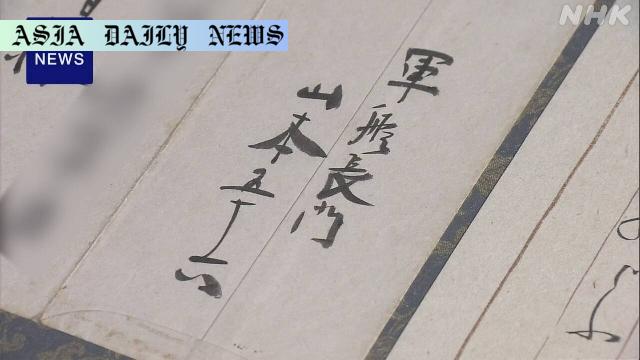Yamamoto Isoroku – Letters by the Japanese officer who led the Pearl Harbor attack to be exhibited, showcasing WWII insights.
The letters, written by Yamamoto Isoroku, provide rare historical insight into WWII strategies.
Exhibited to coincide with the 80th anniversary of WWII, the letters reveal Yamamoto’s thoughts on Pearl Harbor and the broader conflict.
Personal anecdotes highlight Yamamoto’s humanity and sense of responsibility.

The Historical Importance of Yamamoto Isoroku’s Letters
Yamamoto Isoroku, the figure at the helm of Japan’s infamous Pearl Harbor attack, remains a complex icon in global wartime history. Two of his newly revealed letters, written in the immediate aftermath of the attack, provide fresh insight into his thoughts, motives, and reflections during the WWII era. These valuable artifacts are now being shared with the public for the first time as part of a commemorative exhibition at the Fukushima Museum, marking the 80th anniversary of WWII’s end.
The first letter, dated January 13, 1942, was penned from onboard the battleship Nagato. In it, Yamamoto tactfully discussed the responsibilities he carried as a military commander. Notably, he reflected on Japan’s initial triumph at Pearl Harbor, soberly attributing their success to the “inattention and negligence” of their adversaries. While praising Japan’s achievement, Yamamoto displayed foresight by tempering national euphoria with a cautionary message. The letter suggested he understood that the larger battle ahead would severely test Japan’s endurance and strategic capabilities.
Yamamoto’s Reflections: A Dual Lens into War and Humanity
Another letter, written three months later aboard the battleship Yamato, focused on personal matters. In juxtaposing his strategic oversight with sentiments of duty to his ancestors—to whom he expressed a desire to pay homage after the war—Yamamoto’s conflicted humanity comes to light. It is known that Yamamoto studied in the United States at Harvard University and profoundly understood the vast differences in national power between Japan and America. This background likely influenced his reluctance to go to war against such a formidable opponent. Nevertheless, as a soldier, he complied with his nation’s directives and led the Pearl Harbor operation with calculated efficiency.
What the Letters Reveal About Strategic Mindsets
These two letters reaffirm Yamamoto’s reputation as a tactician and a realist. His analysis of the Pearl Harbor attack as merely a “minor victory” against an unprepared enemy demonstrates his deep awareness of Japan’s precarious position. While the Japanese populace celebrated, Yamamoto maintained a soldier’s discipline by focusing on future battles and the significant challenges ahead. Museum curators have said these letters hold immense historical value in understanding not just Japanese wartime leadership but also the importance of evaluating war beyond immediate victories. They shed light on a man who, despite being seen as an adversary in the West, holds lessons in leadership, pragmatism, and foresight.
The addition of personal reflections, such as his expressed yearning for peace and family duty, humanizes Yamamoto beyond his role as a wartime commander. Amid the chaos of conflict, moments of humanity, like those revealed in the letters, offer a poignant reminder of the divided loyalties every military leader must face.
Conclusion: An Opportunity for Reflection
The newly unveiled letters of Yamamoto Isoroku give historians, scholars, and the public a rare look into a period that forever shaped the modern world. They serve as a reminder of the complexities of leadership during wartime and the weight of strategic responsibility. As modern audiences reflect on historic conflicts, Yamamoto’s words compel us to consider the cost, both personal and national, of aggressive warfare. The exhibition at Fukushima Museum invites visitors to engage with this legacy, understand the contradictions of war, and evaluate the lessons it holds for future generations.



Commentary
The Significance of Unveiling Yamamoto’s Letters
The decision to exhibit Yamamoto Isoroku’s letters is both a timely and necessary endeavor to help illuminate a critical chapter of World War II. As the 80th anniversary of its conclusion approaches, these documents are more than just relics; they are a window into the mind of a strategic leader who, despite his role in initiating a devastating attack, embodied both foresight and restraint. Understanding Yamamoto’s nuanced perspective is vital in re-evaluating how wars are fought and the decisions behind them.
A Man of Strategy and Stature
Yamamoto was no ordinary wartime figure; he was a highly educated commander with firsthand experience of Western culture and an acute understanding of Japan’s limitations. His letters reveal a sophisticated understanding of the dynamics of power. By describing the Pearl Harbor success as “a minor victory,” Yamamoto highlighted the challenges Japan would face in a prolonged conflict. This insight offers a stark contrast to the often jubilant or defiant wartime rhetoric of the era, shedding light on Yamamoto’s strategic, albeit conflicted, mindset.
Historical and Human Value
Ultimately, these letters highlight the duality of Yamamoto’s life—a sense of duty to his nation juxtaposed with personal aspirations and realism about war’s costs. For the international community, this exhibition not only deepens historical understanding but also serves as an opportunity to reflect on the recurring themes of war, strategy, and leadership. Through these personal writings, we are reminded that even in moments of conflict, humanity’s enduring qualities of reflection and foresight persist.